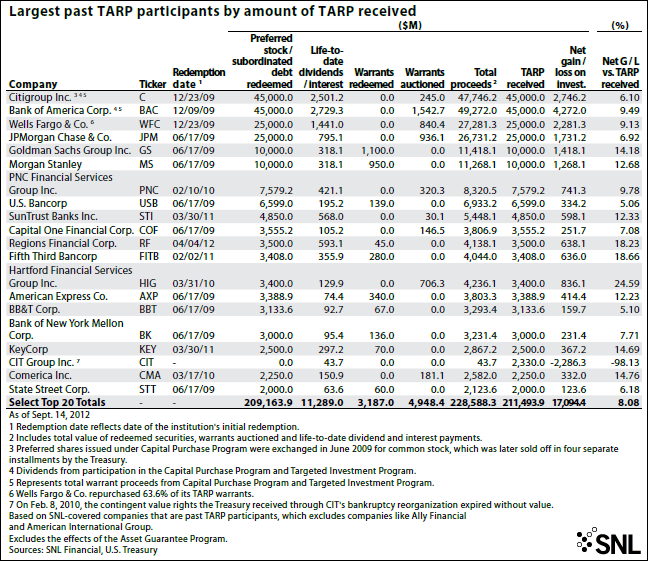

| Visitors Now: | |
| Total Visits: | |
| Total Stories: |
Treasury’s returns on TARP cash cows
By Thomas Mason and Andrew Wolcott, SNL Financial

American International Group Inc. says it is now in the black on its obligations to the U.S. Treasury Department and Federal Reserve Bank of New York — and then some — following the Treasury’s latest stock sale.
With the sale of 636.9 million shares, which generated $20.7 billion in proceeds for the Treasury, AIG has produced a positive return of roughly $15.1 billion for the Treasury and the Federal Reserve Bank of New York, the latter of which also provided funds to the insurer amid the financial crisis.
The Treasury still has about 234.2 million common stock shares left, and based on AIG’s Sept. 13 closing price of $34.44 per share, that could provide an additional $8.1 billion. (For a visual breakdown of the Treasury and the New York Fed’s investments in AIG, click here.)
While that could mean a decent payday for the Treasury, a look at other large TARP investments in the financial services space shows even better relative returns.

For instance, fellow insurer The Hartford Financial Services Group Inc. booked an $836.1 million gain for the Treasury on an investment of about $4.24 billion, according to SNL data.
The return on The Hartford investment is even more impressive taking into account the time value of money, as The Hartford was under TARP for a shorter amount of time than several of the other large financial services institutions. A simple present-value equation — assuming the life-to-date dividends/interest were paid in equal, quarterly amounts and using the total proceeds as the future value — yields an annualized rate of return of about 34.6% for The Hartford investment, based on the number of days between the initial investment and the redemption date.
While this is an approximation, it nonetheless gives a rough sense of the time-weighted rate of return for the Treasury. Using the same analysis, American Express Co. was another high-return investment, at north of 30%, as were Goldman Sachs Group Inc. and Morgan Stanley, which each led to returns of about 25%. Goldman performed this exact calculation when it exited the TARP program, saying in a July 2009 news release that it created a 23% annualized return for U.S. taxpayers, based on the $1.42 billion it paid on the Treasury’s $10 billion investment.
Then again, not all of the investments were profitable. CIT Group Inc., for instance, never repaid the $2.33 billion that the Treasury plowed into it, as the New York-based lender filed for bankruptcy Nov. 1, 2009.
In the context of the broader market, the total return on the S&P 500 from Oct. 28, 2008 — when TARP was granted to the majority of these large recipients — to Sept. 13 is a whopping 69.4%, far outpacing any of the returns from the investments examined in this analysis.
Click here to view in Excel the full list of companies that have redeemed TARP under the Capital Purchase Program




